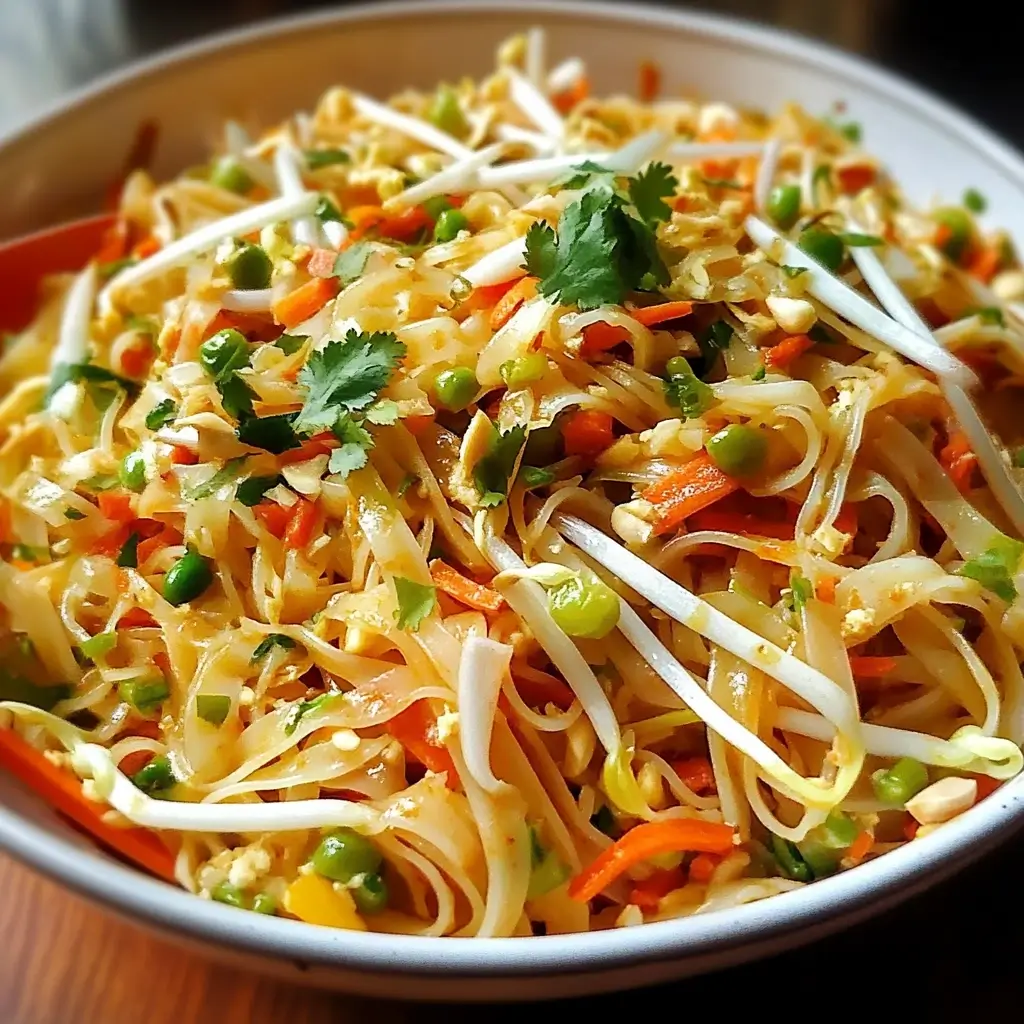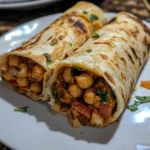It was one of those hectic Tuesday evenings. The kind where everyone’s hungry, a little grumpy from the day, and the thought of spending hours in the kitchen feels utterly overwhelming. I remembered a Quick Veggie Pad Thai recipe I’d been meaning to try, promising big flavors with minimal fuss. Skeptical but desperate, I pulled out the ingredients. To say it was a revelation would be an understatement! The kitchen quickly filled with the most incredible aromas – tangy tamarind, savory soy, a hint of spice. My partner, usually a staunch meat-eater, wandered in, drawn by the scent. Even my picky teenager peeked around the corner. In less than 30 minutes, we were sitting down to steaming bowls of vibrant, noodle-y goodness. The balance of sweet, sour, salty, and umami was spot on, the veggies were perfectly tender-crisp, and the soft rice noodles were an absolute dream. My partner devoured his portion and even asked for seconds, proclaiming it “better than takeout!” My teenager, who usually pushes vegetables around her plate, actually ate all her bell peppers and carrots. This Quick Veggie Pad Thai hasn’t just become a weeknight staple in our home; it’s a testament to how incredibly satisfying and easy plant-based eating can be. It’s our go-to for a speedy, healthy, and crowd-pleasing meal that never fails to impress.
Ingredients
Here’s what you’ll need to create this sensational Quick Veggie Pad Thai, serving approximately 2-3 hungry adults or 4 smaller portions:
- Rice Noodles (8 ounces / 225g): Preferably flat rice noodles, about 1/4-inch wide (Pad Thai or “Linguine-style” rice noodles). These are the classic choice, offering a delightful chewiness.
- Firm or Extra-Firm Tofu (14-16 ounces / 400-450g): Pressed and cut into 1-inch cubes. Pressing removes excess water, allowing the tofu to crisp up beautifully and absorb more flavor.
- Soy Sauce or Tamari (1 tablespoon): For marinating the tofu. Tamari keeps it gluten-free.
- Cornstarch (1 tablespoon): To give the tofu a light, crispy coating.
- Avocado Oil or other high-heat cooking oil (3-4 tablespoons, divided): For stir-frying. Avocado oil has a high smoke point, ideal for this type of cooking.
- Garlic (3-4 cloves): Minced. Fresh garlic is key for aromatic depth.
- Fresh Ginger (1-inch piece): Peeled and minced or grated. Adds a warm, zesty kick.
- Shallot (1 large or 2 small): Thinly sliced. Milder and more delicate than onion, perfect for Pad Thai. (A small red onion can be substituted).
- Carrots (2 medium): Julienned or thinly sliced into matchsticks. They add sweetness and a pleasant crunch.
- Bell Pepper (1 large, any color): Thinly sliced. Red, yellow, or orange bell peppers offer sweetness and vibrant color.
- Broccoli Florets (1 cup): Cut into small, bite-sized pieces. Adds a lovely green and great texture.
- Bean Sprouts (2 cups, divided): Fresh and crunchy. Half will be cooked, half used for garnish.
- Scallions/Green Onions (3-4): Sliced, whites and greens separated. Whites are cooked for flavor, greens used as a garnish.
For the Pad Thai Sauce:
- Tamarind Paste/Pulp (3 tablespoons): This is the heart of Pad Thai, providing its signature tang. Use unsweetened paste; if using concentrate, you may need less and more water.
- Hot Water (1/4 cup): To dissolve the tamarind paste if it’s very thick.
- Soy Sauce or Tamari (3 tablespoons): For savory depth and umami.
- Brown Sugar or Coconut Sugar (2-3 tablespoons): To balance the sourness of the tamarind. Adjust to your preferred sweetness.
- Rice Vinegar (1 tablespoon): Adds another layer of acidity and brightness.
- Lime Juice (1 tablespoon, fresh): For a final zesty kick. Freshly squeezed makes a big difference.
- Sriracha or Chili Garlic Sauce (1-2 teaspoons, or to taste): For a touch of heat. Optional but recommended.
For Garnish (Highly Recommended):
- Roasted Peanuts (1/4 cup): Roughly chopped. Adds essential crunch and nutty flavor.
- Fresh Cilantro (1/4 cup): Roughly chopped. Brightens the dish with its fresh, herbaceous notes.
- Lime Wedges: For squeezing over the finished dish, enhancing all the flavors.
- Red Pepper Flakes (optional): For those who like an extra kick of spice.
Instructions
Follow these steps carefully for a perfect Quick Veggie Pad Thai every time:
- Prepare the Noodles: Cook or soak the rice noodles according to package directions. Typically, this involves soaking them in hot (not boiling) water for 5-10 minutes until pliable but still slightly firm (al dente). They will cook further in the pan. Drain them well and rinse with cold water to stop the cooking process and prevent sticking. Set aside. Pro Tip: A little toss with a teaspoon of oil can also help prevent sticking.
- Prepare the Tofu: While the noodles are soaking, press your tofu. If you don’t have a tofu press, wrap the block in a few layers of paper towels or a clean kitchen towel. Place it on a plate, and put something heavy on top (like a few cookbooks or a cast iron skillet) for at least 15-20 minutes. Once pressed, cut the tofu into 1-inch cubes. In a medium bowl, toss the tofu cubes gently with 1 tablespoon of soy sauce (or tamari) and 1 tablespoon of cornstarch until evenly coated.
- Mix the Pad Thai Sauce: In a small bowl, whisk together the tamarind paste (if using thick pulp, dissolve it in the 1/4 cup hot water first, then strain out any seeds if necessary), soy sauce (or tamari), brown sugar, rice vinegar, lime juice, and Sriracha (if using). Taste and adjust seasonings if needed – it should be a harmonious blend of tangy, sweet, salty, and a little spicy. Set aside.
- Cook the Tofu: Heat 1-2 tablespoons of avocado oil in a large skillet, wok, or heavy-bottomed pan over medium-high heat. Once the oil is shimmering, add the coated tofu cubes in a single layer (cook in batches if necessary to avoid overcrowding). Cook for 5-7 minutes, turning occasionally, until golden brown and crispy on all sides. Remove the tofu from the pan and set aside on a plate.
- Sauté Aromatics and Hardy Vegetables: Add another tablespoon of oil to the same pan if needed. Reduce heat to medium. Add the minced garlic, ginger, and sliced shallots (or red onion). Sauté for about 1-2 minutes until fragrant – be careful not to burn the garlic.
- Stir-fry Vegetables: Increase the heat back to medium-high. Add the julienned carrots, sliced bell pepper, and broccoli florets to the pan. Stir-fry for 3-5 minutes until they are tender-crisp. You want them to retain some bite.
- Combine and Cook: Push the vegetables to one side of the pan. Add the drained rice noodles and half of the bean sprouts to the empty side. Pour the prepared Pad Thai sauce all over the noodles and vegetables. Gently toss everything together to combine well, ensuring the noodles are fully coated in the sauce. Cook for another 2-3 minutes, stirring frequently, allowing the noodles to absorb the sauce and cook through. If the pan seems dry, add a tablespoon or two of water.
- Add Tofu and Finish: Add the cooked tofu and the white parts of the scallions to the pan. Toss gently to combine and heat through for about 1-2 minutes.
- Serve Immediately: Divide the Quick Veggie Pad Thai among serving bowls. Garnish generously with the remaining fresh bean sprouts, chopped roasted peanuts, fresh cilantro, the green parts of the scallions, and a lime wedge on the side for squeezing. Offer extra red pepper flakes if desired.
Nutrition Facts
- Servings: This recipe typically yields 2-3 large servings or 4 moderate servings.
- Calories per serving (approximate for 1 of 3 large servings): Around 550-650 kcal. (This can vary based on exact ingredient amounts, oil used, and sugar content).
Key Nutrition Highlights (per approximate large serving):
- Protein (approx. 20-25g): Primarily from the tofu and peanuts, essential for muscle repair, satiety, and overall bodily functions. This makes it a satisfying vegetarian meal.
- Fiber (approx. 8-10g): Contributed by the vegetables, rice noodles (especially if using brown rice noodles), and peanuts. Fiber aids digestion, helps regulate blood sugar, and promotes fullness.
- Healthy Fats (approx. 20-25g): Mainly from the avocado oil and peanuts. These include monounsaturated and polyunsaturated fats, which are beneficial for heart health when consumed in moderation.
- Vitamin C (Significant % of RDI): From bell peppers, broccoli, lime juice, and bean sprouts. Vitamin C is a powerful antioxidant that supports the immune system and collagen production.
- Iron (Good Source): Tofu, broccoli, and peanuts provide a decent amount of plant-based iron, important for oxygen transport in the blood and energy production.
Preparation Time
- Total Estimated Time: 25-35 minutes
- Prep Time (Chopping, Soaking, Mixing Sauce): Approximately 15-20 minutes. This includes soaking the noodles, pressing and cubing the tofu, chopping all the vegetables, mincing garlic and ginger, and whisking together the sauce. Efficient multi-tasking (e.g., prepping veggies while tofu presses or noodles soak) can shorten this.
- Cook Time (Stir-frying): Approximately 10-15 minutes. This is the active cooking phase, from crisping the tofu to tossing everything together in the wok.
This Quick Veggie Pad Thai truly lives up to its name, making it an ideal choice for busy weeknights when you crave something flavorful and satisfying without spending hours in the kitchen.
How to Serve
Serving Pad Thai is all about embracing the vibrant colors, textures, and aromas. Here’s how to present your Quick Veggie Pad Thai for the ultimate experience:
- Individual Bowls:
- Ladle generous portions of the hot Pad Thai into individual shallow bowls or pasta plates. This allows each person to customize their garnishes.
- Ensure a good distribution of noodles, tofu, and vegetables in each serving.
- Family-Style Platter:
- For a more communal feel, arrange the Pad Thai on a large serving platter.
- Pile the noodles high in the center, ensuring the colorful veggies and tofu are visible.
- This makes an impressive centerpiece for the table.
- Garnish Extravaganza: Garnishes are NOT optional for Pad Thai; they elevate the dish significantly!
- Crucial Crunch & Nuttiness: Sprinkle generously with roughly chopped roasted peanuts.
- Freshness Burst: Add a handful of fresh cilantro leaves (roughly chopped or whole leaves).
- Essential Zest: Place lime wedges on the side of each bowl or around the platter. Squeezing fresh lime juice over the Pad Thai just before eating brightens all the flavors.
- Cool Crispness: Scatter fresh bean sprouts over the top. These add a wonderful textural contrast to the soft noodles.
- Aromatic Finish: Sprinkle with the sliced green parts of the scallions.
- Optional Heat: Offer a small bowl of red pepper flakes or extra Sriracha on the side for those who like it spicier.
- Accompaniments (Optional):
- While Pad Thai is a complete meal in itself, a simple side of sliced cucumbers or a light, tangy Thai cucumber salad can be a refreshing counterpoint.
- A small dish of chili oil or chili garlic sauce can be provided for extra flavor and heat.
- Presentation Tips:
- Wipe the rims of the bowls or platter clean for a neat presentation.
- Try to showcase the different colors of the vegetables and the golden-brown tofu.
- The aroma will do half the work – serve it steaming hot!
By paying attention to these serving details, you transform a simple noodle dish into an exciting and inviting culinary experience.
Additional Tips
To ensure your Quick Veggie Pad Thai is a roaring success every single time, here are eight additional tips:
- Noodle Perfection is Key: The most common Pad Thai pitfall is mushy noodles. To avoid this, soak your rice noodles in very hot tap water (or just boiled water that has cooled for a minute or two) rather than continuously boiling them. Soak only until they are pliable but still have a slight firmness (al dente). They will finish cooking in the wok with the sauce. Rinsing them with cold water immediately after draining stops the cooking process and washes off excess starch, preventing sticking.
- Embrace Real Tamarind: While some recipes suggest lime juice and brown sugar as a tamarind substitute, true Pad Thai flavor comes from tamarind paste or pulp. Look for it in Asian grocery stores or the international aisle of larger supermarkets. Tamarind paste (often sold in a jar) is concentrated, so you’ll use less and dilute it. Tamarind pulp (in a block) needs to be soaked in hot water, then squeezed and strained to extract the sour liquid. The unique tangy, fruity sourness it provides is irreplaceable.
- High Heat, Quick Cooking (Wok Hei): Pad Thai benefits from being cooked quickly over relatively high heat, especially if you’re using a wok. This imparts a subtle smoky flavor known as “wok hei” (breath of the wok). Have all your ingredients prepped and within reach (mise en place) before you start cooking, as the stir-frying process moves fast.
- Don’t Overcrowd the Pan: This is crucial for achieving crispy tofu and perfectly cooked veggies. If you add too many ingredients at once, the pan’s temperature will drop, and your ingredients will steam rather than stir-fry. Cook tofu in batches if necessary. Similarly, if making a very large batch of Pad Thai, consider stir-frying the noodles and vegetables in two separate batches.
- Taste and Adjust the Sauce: The “perfect” Pad Thai sauce balance is subjective. Some like it sweeter, others tangier, or spicier. Before adding the sauce to the noodles, give it a taste. Does it need more sugar for sweetness? More lime juice or tamarind for tang? More soy sauce for saltiness/umami? More Sriracha for heat? Adjust accordingly. It’s easier to adjust the sauce before it’s mixed with everything else.
- Protein Power-Up & Variations: While this recipe features tofu, feel free to experiment. Edamame (shelled) can be added with the vegetables for extra protein and texture. If you’re not strictly vegetarian, cooked shrimp or thinly sliced chicken are traditional additions (cook them separately and add them in with the tofu). For a different vegan twist, pan-fried tempeh or seitan could also work.
- Veggie Versatility: Don’t feel limited by the vegetables listed. Pad Thai is very forgiving. Other great additions include thinly sliced mushrooms (shiitake or cremini), snow peas, sugar snap peas, bok choy (sliced), or even shredded cabbage. Just be mindful of cooking times – add harder veggies first and more delicate ones later. The goal is tender-crisp, not mushy.
- Making it Truly Vegan: This recipe is easily made vegan. Ensure your brown sugar is vegan (some are processed with bone char; organic usually is). Double-check that your Sriracha or chili garlic sauce doesn’t contain fish products (most don’t, but it’s worth a quick label read). Traditional Pad Thai often includes fish sauce; this recipe omits it and relies on soy sauce/tamari and the other flavorful components for its umami depth, making it inherently vegetarian and easily vegan.
Frequently Asked Questions (FAQ)
Here are answers to some common questions about making Quick Veggie Pad Thai:
- Q: Can I make this recipe gluten-free?
A: Absolutely! The main ingredient to watch is soy sauce. Simply substitute traditional soy sauce with Tamari, which is a Japanese soy sauce typically made without wheat, or look for a specifically labeled gluten-free soy sauce. Rice noodles are naturally gluten-free, but always double-check packaging if you have celiac disease or severe gluten sensitivity. Cornstarch is also gluten-free. - Q: What if I can’t find tamarind paste? Is there a substitute?
A: Tamarind is really the star flavor, but if you’re in a pinch, you can try a combination of lime juice and brown sugar. For every tablespoon of tamarind paste called for, you could try using 1 tablespoon of lime juice mixed with 1 tablespoon of brown sugar or molasses. Some people also add a tiny splash of rice vinegar or ketchup for complexity. However, the flavor will be noticeably different and less authentic. If possible, ordering tamarind paste online is a great option if local stores don’t carry it. - Q: My Pad Thai noodles always end up mushy or sticky. What am I doing wrong?
A: This is a common issue! Avoid overcooking the noodles during the initial soaking/boiling phase. Soak them in hot (not vigorously boiling) water just until pliable but still slightly firm (al dente). Drain and immediately rinse with cold water to stop cooking and remove excess starch. Also, don’t overcrowd the pan when stir-frying, and avoid over-stirring once the noodles are in the pan with the sauce, as this can break them down. - Q: How can I adjust the spice level of my Pad Thai?
A: It’s very easy to customize the heat. For a milder version, reduce or omit the Sriracha or chili garlic sauce in the sauce mixture. You can also serve red pepper flakes on the side so individuals can add their own heat. For a spicier version, increase the amount of Sriracha/chili garlic sauce, or add a pinch of cayenne pepper to the sauce, or even toss in a few thinly sliced Thai bird’s eye chilies with the garlic and ginger (use with caution!). - Q: How do I store and reheat leftover Pad Thai?
A: Store leftover Pad Thai in an airtight container in the refrigerator for up to 2-3 days. To reheat, you can gently warm it in a skillet over medium-low heat, adding a tablespoon or two of water if it seems dry to help steam and loosen the noodles. You can also microwave it, though the texture might not be as good. Add fresh garnishes (peanuts, cilantro, lime) after reheating for the best flavor. - Q: Can I use other types of noodles?
A: While flat rice noodles (Pad Thai noodles) are traditional and provide the best texture, you could experiment with other rice noodles like thinner vermicelli if that’s all you have, though the experience will be different. Wheat-based noodles like linguine or spaghetti are not recommended as they will significantly alter the dish’s character and won’t absorb the sauce in the same way. - Q: What’s the best way to press tofu without a tofu press?
A: Wrap the block of tofu in several layers of paper towels or a clean, lint-free kitchen towel. Place it on a plate. Put another plate on top of the wrapped tofu, and then weigh it down with something heavy, like a few heavy cookbooks, a cast iron skillet, or a few large cans of food. Let it press for at least 20-30 minutes, changing the paper towels if they become saturated. This removes excess water, leading to crispier tofu. - Q: Can I prepare any components of this dish ahead of time?
A: Yes, to save time! You can chop all your vegetables, mince the garlic and ginger, and slice the shallots a day in advance; store them in airtight containers in the refrigerator. The Pad Thai sauce can also be whisked together and stored in an airtight container in the fridge for several days. You can also press and cube the tofu ahead of time. Then, when you’re ready to cook, it’s just a matter of soaking noodles and stir-frying!






